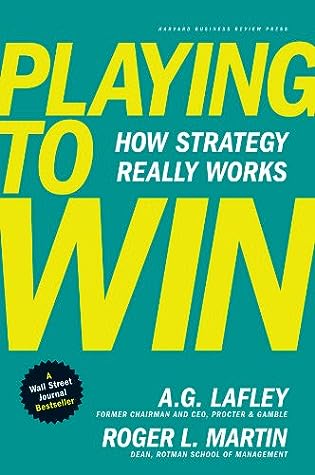More on this book
Community
Kindle Notes & Highlights
by
A.G. Lafley
Read between
November 30, 2015 - January 8, 2016
Really, strategy is about making specific choices to win in the marketplace.
Strategy therefore requires making explicit choices—to do some things and not others—and building a business around those choices.
strategy is an integrated set of choices that uniquely positions the firm in its industry so as to create sustainable advantage and superior value relative to the competition.
But it is only through making and acting on choices that you can win. Yes, clear, tough choices force your hand and confine you to a path. But they also free you to focus on what matters.
a strategy is a coordinated and integrated set of five choices: a winning aspiration, where to play, how to win, core capabilities, and management systems.
What is your winning aspiration? The purpose of your enterprise, its motivating aspiration. Where will you play? A playing field where you can achieve that aspiration. How will you win? The way you will win on the chosen playing field. What capabilities must be in place? The set and configuration of capabilities required to win in the chosen way. What management systems are required? The systems and measures that enable the capabilities and support the choices.
Aspirations are statements about the ideal future. At a later stage in the process, a company ties to those aspirations some specific benchmarks that measure progress toward them.
To determine how to win, an organization must decide what will enable it to create unique value and sustainably deliver that value to customers in a way that is distinct from the firm’s competitors. Michael Porter called it competitive advantage—the specific way a firm utilizes its advantages to create superior value for a consumer or a customer and in turn, superior returns for the firm.
Two questions flow from and support the heart of strategy: (1) what capabilities must be in place to win, and (2) what management systems are required to support the strategic choices?
A strategy is a coordinated and integrated set of where-to-play, how-to-win, core capability, and management system choices that uniquely meet a consumer’s needs, thereby creating competitive advantage and superior value for a business. Strategy is a way to win—and nothing less.
Focus is a crucial winning attribute. Attempting to be all things to all customers tends to result in underserving everyone.
A company with a competitive advantage earns a greater margin between revenue and cost than other companies do for engaging in the same activity.
The activity system is a visual representation of the firm’s competitive advantage, capturing on a single page the core capabilities of the firm.
Articulating a firm’s core capabilities is a vital step in the strategy process. Identifying the capabilities required to deliver on the where-to-play and how-to-win choices crystallizes the area of focus and investment for the company. It enables a firm to continue to invest in its current capabilities, to build up others, and to reduce the investment in capabilities that are not essential to the strategy.
Rather than starting with capabilities and looking for ways to win with those capabilities, you need to start with setting aspirations and determining where to play and how to win. Then, you can consider capabilities in light of those choices. Only in this way can you see what you should start doing, keep doing, and stop doing in order to win.
the activity system captures the core capabilities required to win, the relationships between them, and the activities that support them; this map supports where-to-play and how-to-win choices, as shown in figure 5-1.
It is essential that all of the systems have at least some capabilities and activities that line up with the core capabilities of the organization.
These shared capabilities—the ones that run through multiple divisions or units and the organization overall—create reinforcing rods that link different parts of the organization together,
The activity system should be feasible, distinctive, and defensible if it is to enable you to win.
assertive inquiry.


